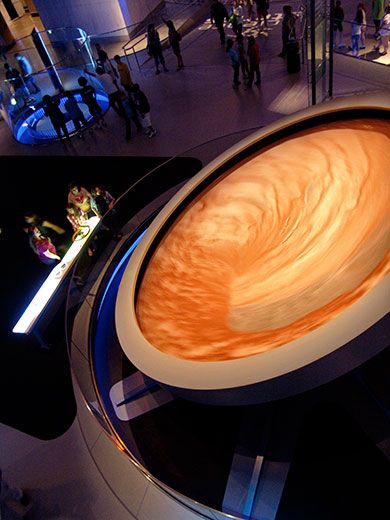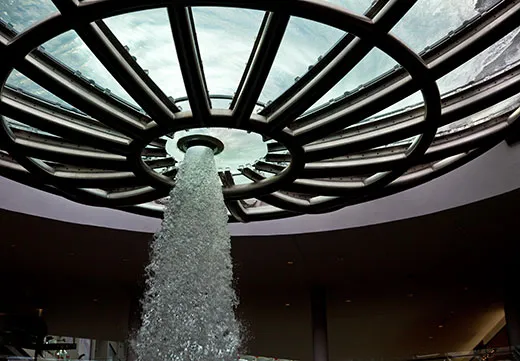Ned Kahn: The Limits of the Knowable
By channeling the elements of wind and water, the environmental sculptor’s designs inspire awe and curiosity in museum visitors
/https://tf-cmsv2-smithsonianmag-media.s3.amazonaws.com/filer/Ned-Kahn-rain-oculus-631.jpg)
Last June, sculptor Ned Kahn’s 17-year-old son approached him with a box.
“I got you a traditional Father’s Day gift,” Ben Kahn warned his Dad. “But it’s not a traditional Father’s Day gift.“
Inside was a tie—made of polished, perforated aluminum. The gift was especially significant because Ben had fashioned it in the workshop of San Francisco’s Exploratorium: the legendary hands-on science museum where Ned had served as artist-in-residence for 14 years.
Even so, the tie seemed incongruous; a more appropriate gift might have been a silk-lined hard hat. Though Kahn appears pensive and soft-spoken, this large-scale environmental artist has won international acclaim by building tornadoes, orchestrating the wind and channeling ocean tides into explosive blowholes.
Kahn, a youthful 51, has a narrow face and dark eyes that often focus in the distance. He majored in botany and environmental science at the University of Connecticut, then worked at the Exploratorium from 1982 until 1996. Physicist Frank Oppenheimer, the museum’s brilliant and eccentric founder (and the younger brother of J. Robert Oppenheimer), became his mentor.
“Finally, I had someone I could ask all the questions that had been puzzling me for years. Like, ‘What’s actually flowing through a wire when you turn on the light?’ Frank loved questions like that,” recalls Kahn. “He would lead me through all the electricity exhibits in the museum, explaining them in detail. Then he’d end this long explanation by saying, ‘Basically, we don’t know what flows through a wire!’
“It was an awakening. It made me realize that what we do know of the world is based on our view through very small windows. The whole idea of limits—the limits of what’s really knowable—has been woven through everything I’ve done.”
Kahn’s interactive Tornado—an eight-foot-high fog twister that visitors can literally walk through without being carried away to Oz—is still one of the Exploratorium’s signature attractions. It’s a good example of what Kahn means when he refers to his pieces as “turbulent landscapes.” For nearly 30 years, he has been fascinated by the dynamic interplay of natural forces that operate, often invisibly, around us.
“I spent a year trying to make that first tornado sculpture work,” Kahn confesses with barely concealed amusement. “Sometimes I’d be there late at night. I’d aim the fans and the fog machine, and get it all fine-tuned. The thing would be working perfectly! Then I’d come back the next morning, and it wouldn’t work at all. I was going crazy.
“After months of this, I realized that it was all about the air currents in that old, drafty Exploratorium building. Which doors were open, or where the sun was heating the roof, affected everything. It slowly dawned on me, how intertwined the sculpture was with the building’s entire air system.
“This made me think: Where does an environmental sculpture begin, and where does it end? If my tornado was being affected by the air currents in the building, which were being affected by the wind outside the building, there never was a real border between the sculpture and the whole atmosphere of the Earth.”
* * *
Ned Kahn lives and works in Graton, a small town about 50 miles north of San Francisco. His studio is filled with motors, pipes, metalworking machinery and prototypes for kinetic sculptures. It looks like a salvage yard for spaceship parts.
His early works modeled on a Lilliputian scale the gigantic, always interactive forces of nature. Air columns filled with microscopic beads created patterns of ever-changing sand dunes; spinning glass orbs filled with a clever mix of colored liquid soaps appeared to contain the atmospheric storms seething across Neptune or Jupiter.
As he received more public art commissions, his works grew larger. New “tornadoes,” commissioned by science museums in the United States and Europe, added several stories in height. Whirlpools and blowholes were installed near city piers; the bare walls of buildings were surfaced with thousands of tiny hinged aluminum panels, animated by the ever-shifting patterns of the wind. In 2003 Kahn’s environmental art was recognized by the MacArthur Foundation, which awarded him a “genius” grant. Far from making him feel self-important, the honor has given him a droll perspective on the art world.
“It’s much easier to generate ideas than come up with something that really works,” Kahn observes, spinning a fluid-filled sphere called Turbulent Orb. “One of the dangerous things about becoming a MacArthur Fellow is that people start to take even your half-baked ideas seriously. It makes me nervous … because a lot of my ideas are bad!”
But a large percentage of his ideas are brilliant. Recently unveiled projects include the 20-foot diameter Avalanche at Chicago’s Museum of Science and Industry, and the astounding Rain Oculus: a 70-foot-wide whirlpool at the Marina Bay Sands complex in Singapore (designed with architect Moshe Safdie). The huge whirlpool—which can circulate 6,000 gallons of water per minute—functions as a kinetic sculpture, a skylight (and waterfall) for the shopping arcade below, and part of the building’s rain-collecting system.
“I love working with Ned,” says Safdie. “His installations not only harness the forces of nature, but—more relevantly—teach us about them. Since my architecture is about working in harmony with nature, this is a perfect fit. I think we both come out feeling enriched, and that our own work is profoundly complemented by the other’s.”
Avalanche, meanwhile, is a movable wheel filled with a mixture of irregular garnet sand and tiny, spherical glass beads. Flowing together, they evoke the dynamics of moving soil, sand and snow. For this project Kahn consulted with University of Chicago physicist Sidney Nagel, who studies the behavior of water droplets, granular matter and other “disordered systems.”
“The enormous wheel is mesmerizing, as small avalanches build up and interact with one another,” Nagel observes. “Ned has the intuition and insight to see how something that starts out small and simple can take on layers of texture when it is enlarged. He captures the playfulness of the scientist in the lab—on our best days!—and translates the excitement of discovery so that it can be enjoyed by all.”
* * *
Kahn often works on dozens of projects simultaneously. At this writing they include everything from a Cloud Arbor (a mist sculpture for the Pittsburgh Children’s Museum) to an installation on the side of a giant parking garage in Brisbane, Australia. But he finds himself drawn increasingly to works that go beyond the purely aesthetic.
“I’ve been getting more excited about projects where what I’m doing is useful; where the artwork actually has some benefit to the building,”
Solar panels, he believes, can be made far more attractive. “And wind turbines are a great interest of mine,” Kahn says. “There’s a lot of backlash against wind power; people think it’s ugly and noisy and kills birds. I think there’s a potential for me to help change people’s attitudes, and show that you can do it in beautiful ways.”
A current commission, for the new PUC building in San Francisco (in collaboration with KMD Architects), takes a revolutionary approach to wind power. When completed, a wide channel running up the side of the 12-story building will hold a tower of sculptural wind turbines, feeding electricity directly into the building’s power grid.
“How much? No one’s certain. Because what we’re doing—using the architecture as a wind funnel—is uncharted territory. Even the people who make the turbines are excited to see what they can do!”
Laced with thousands of tiny yellow-green lights, the facade of the building will flicker at night like a grid of fireflies, revealing otherwise invisible wind currents.
As the scale of his projects increase, his ideas become ever wilder. He’s currently researching how water droplets generate electrical charges, a process that produces famously dramatic results. “I’ve been working on designs for a fountain that will store and create electrical discharges,” he grins. “A sculpture that would produce real lightning.”
For an artist preparing to throw thunderbolts around, Ned Kahn remains remarkably unpretentious. This arises in part from his 30-plus years of morning vipassana (mindfulness) meditation, as well as the fact that he’s usually channeling forces much larger than himself.
“Most sculptures are a celebration of the skill of the artist,” he admits. “But in the things that I make—even though I’ve created the structure—it’s really not me that’s doing the sculpting. I’ve assembled the symphony, and the musicians, but something besides me is actually composing and recomposing the piece.”
To date, Ned Kahn has collaborated with more than 25 architecture and design companies around the world. With so much time scheduled on hard-hat construction sites, I can’t help but wonder when he’ll next put on that tie.
“Hopefully, never,” Kahn laughs. “I’m just not a tie guy. But it is a good conversation starter.”



